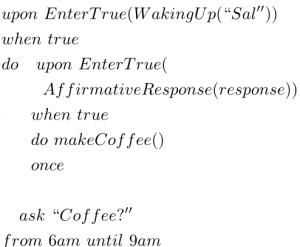Notes on Ubiquitous Computing’ Dominant Vision: Tomorrow Never Dies
Authors Bell and Dourish of ‘Yesterday’s Tomorrows: notes on ubiquitous computing’s dominant vision’ [1] write a call to reason for future researchers to resist the alluring “proximate future” tense as this excuses tackling the problems of today whilst also justifying ubicomp as an inevitable reality of the future. Criticism for researchers continues with claims of reluctance to embrace the messy and dynamic infrastructures that host computation for present day society, preferencing Weiser’s technology-saturated future that lies just around the corner in his 1991 article ‘The Computer for the Twenty First Century’ [2]. Current problems miraculously sort themselves out with the passing of time.
As the paper progresses in describing the rapid uptake and implementation of technology thereby – incorrectly in my opinion – deeming countries Singapore and South Korea as ’ubiquitous environments’, the authors at- tempt to kill two birds with one stone before prescribing the ’messiness’ of civic infrastructures where transportation and communication act as a viable alternative for ubicomp. Firstly, in selecting two case studies outside of the traditional Westernised imaginings of the future and presenting the realities of technology at a national level, Bell and Dourish show examples of ubiquitous computing as it is currently developing, Bell and Dourish situate a ubicomp of the present, tackling visions of future grandeur such as that of Weiser’s ’Sal’s story’ [3]. Secondly, by doing this the pair throw weight behind a prominent answer to an argument that has been at the heart of ubi- comp for decades; a. Has ubiquitous computing already been accomplished or b. Is it a goal yet to be achieved? (Hint: It’s a. the ”future is already here”) [4] Fortunately no birds were harmed in the making of this paper as both authors miss their feathered friends by attempting to hunt the wrong flock of problems.
Although praise must be given where its due in bringing a non-Westernised experience of technology into the foreground, an increased rapid uptake of computational infrastructure does not necessarily equate to ubiquity. Technology may be an essential component in some disciplines, but we are still a long shot away from the a ’seamless’ application across differing contexts the authors describe. Additionally, I feel there is a fundamental misunderstand- ing with the prolonged discussion of Weiser’s vision and – at risk of angering the authors by indulging in a poignant quote of his -:
As I understand it, this quote dictates not only that computers are so numerous in nature that they become part of the very ’fabric’ of every day life, but that they also sink into the background – as Castells puts it rather chillingly ”like pigment in wall paint” [6], becoming only apparent when needed. There are very few technologies that currently exist do this, perhaps to this extent a revolving door or a thermostat is closer to Weiser’s vision of a smartphone. Ultimately what Bell and Dourish should be asking is not whether we already do or don’t live in Sal’s world, but whether we would want to.

Although instantaneous freshly brewed coffee on request and self-finding lost instruction manuals may initially sound appealing, the issues of privacy, invasiveness and safety of systems that are constantly monitoring our daily activity are not just ’important’ according to the authors, but absolutely essential questions we must ask ourselves for the future.
The short paper that I have selected that exemplifies ubiquitous computing to me is ‘The Broken Dream of Pervasive Sentient Ambient Calm Invisible Ubiquitous Computing‘ – an outright dispute of its whole existence with Weiser’s dream of invisible technology being deemed ‘impossible’, dangerous and dehumanising. Its style is playful, tongue-in-cheek and captivating making it a interesting read of what we can (if anything) to stop the potential information overload and exploitation that ubiquitous computing may bring.
[1] Bell, G. and Dourish, P. (2007) ‘Yesterday’s tomorrows: notes on ubiquitous computing’s dominant vision. Personal and ubiquitous computing’, 11(2), pp.3-9, URL: http://www.dourish.com/publications/2007/BellDourish-YesterdaysTomorrows-PUC.pdf
[2] Weiser, M. (1991) ‘The computer for the 21st century’, Scientific American, 265(3), pp.94-104. URL: http://dl.acm.org/citation.cfm?id=329126
[3] Ibid, p. 9
[4] Gibson, W. (1999) Interview on NPR’s ‘‘Talk of the Nation,’’ 30 November
[5] Wesier, p. 3
[6] Castells, M. (2000) ‘The Rise of the Network Society’, Wiley-Blackwell, London, p. 57
Leave a Reply Cancel reply